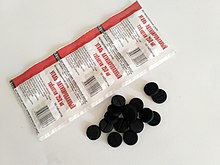 Activated charcoal for medical use | |
| Clinical data | |
|---|---|
| Trade names | CharcoAid, others |
| AHFS/Drugs.com | Monograph |
| Routes of administration | by mouth, nasogastric tube |
| Identifiers | |
| CAS Number | |
| ChemSpider |
|
| UNII | |
| CompTox Dashboard (EPA) | |
| ECHA InfoCard | 100.036.697 |
Activated charcoal, also known as activated carbon, is a medication used to treat poisonings that occurred by mouth.[1] To be effective it must be used within a short time of the poisoning occurring, typically an hour.[1][2] It does not work for poisonings by cyanide, corrosive agents, iron, lithium, alcohols, or malathion.[2] It may be taken by mouth or given by a nasogastric tube.[3] Other uses include inside hemoperfusion machines.[1]
Common side effects include vomiting, black stools, diarrhea, and constipation.[1] A more serious side effect, pneumonitis, may result if aspirated into the lungs.[1][2] Gastrointestinal obstruction and ileus are less common but serious adverse effects.[1] Use in pregnancy and breastfeeding is generally safe.[3] Activated charcoal works by adsorbing the toxin.[1]
While charcoal has been used since ancient times for poisonings, activated charcoal has been used since the 1900s.[4][5] It is on the World Health Organization's List of Essential Medicines.[6]
- ^ a b c d e f g "Charcoal, Activated". The American Society of Health-System Pharmacists. Archived from the original on 21 December 2016. Retrieved 8 December 2016.
- ^ a b c World Health Organization (2009). Stuart MC, Kouimtzi M, Hill SR (eds.). WHO Model Formulary 2008. World Health Organization. p. 57. hdl:10665/44053. ISBN 9789241547659.
- ^ a b Hamilton R (2015). Tarascon Pocket Pharmacopoeia 2015 Deluxe Lab-Coat Edition. Jones & Bartlett Learning. p. 469. ISBN 9781284057560.
- ^ Cecen F, Aktas Ö (2011-09-19). "1". Activated Carbon for Water and Wastewater Treatment: Integration of Adsorption and Biological Treatment. John Wiley & Sons. ISBN 9783527639458. Archived from the original on 2016-12-20.
- ^ Tascón JM (2012). Novel Carbon Adsorbents. Elsevier. p. 640. ISBN 9780080977447. Archived from the original on 2016-12-20.
- ^ World Health Organization (2019). World Health Organization model list of essential medicines: 21st list 2019. Geneva: World Health Organization. hdl:10665/325771. WHO/MVP/EMP/IAU/2019.06. License: CC BY-NC-SA 3.0 IGO.